Tornado with atomic bombs
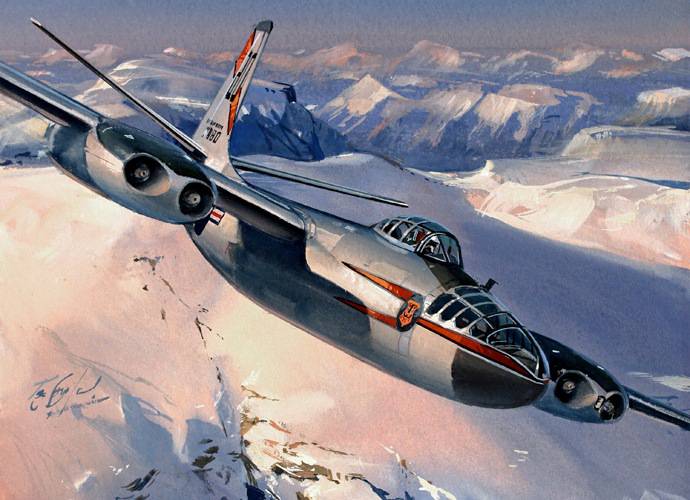
The B-45 Tornado is the first serial American jet bomber. History the creation of this aircraft should be counted from the beginning of the forties, when military aircraft began to be designed in the most technically advanced countries. The undisputed leader in this was Germany. The Germans managed to build several types of serial aircraft with jet engines, including two bomber. One created the firm "Arado", and the second - the firm "Junkers".
The light bomber Arado Ag-234 took off in the summer of 1943, and this event did not go unnoticed across the ocean: North American began developing its own aircraft of a similar purpose, later known as B-45 Tornado.
Preliminary talks between North American management and the US Air Force in October 1943 clarified the characteristics of the future bomber. In February, 1944, the designers of the company began to design a new aircraft that received the code NA-130.
According to the tradition prevailing in the US Air Force, it is customary to develop any aircraft on a competitive basis, and naturally, a promising jet machine was no exception. In addition to North America, Conver, Boeing and Martin built their own bombers. Some history scholars aviation they include Northrop with the B-49, forgetting that this aircraft was created as a heavy bomber and competed with the B-36. The construction of all experimental aircraft was paid from the pocket of the Air Force, although it should be noted that these funds were small.
The Air Force provided companies with complete freedom, so two four-engine (North American XB-45 and Convertible XB-46) and two six-engine (Boeing XB-47 and Martin XB-48) bomber were prepared for the competition.
The design of the aircraft "North American" XB-45 was the most compliant to the requirements of the Air Force for the average bombers. It was a car designed according to the high-wing straight wing scheme. Four TRD firms "Allison" J35 were placed in pairs in the underwing gondolas. The crew included two pilots, a navigator and a gunner.
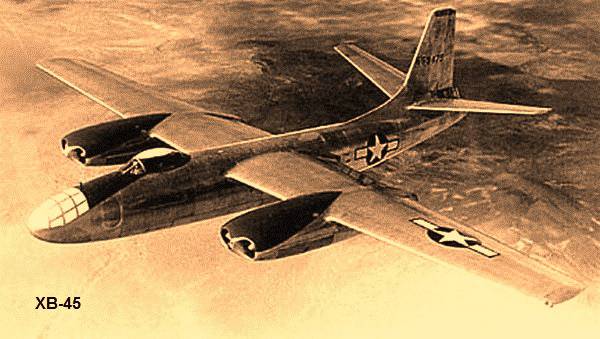
In 1945, the work went at an accelerated pace, the designers worked on 12 hours a day. But when the Second World War ended, the work slowed down. The first prototype bomber prepared for testing only in 1947-m. Disassembled, he was taken to Myurok Air Base, where all the first American jet machines were tested at a carefully classified section of the test complex. In the spring of 1947, test pilots George Krebs and Paul Brewer made their first take-off on the XB-45.
The initial phase of the test passed without problems. At the end of the year, the second prototype machine was joined by the second one, equipped with ejection pilots seats. The navigator and gunner were to leave the bomber through the hatches. In December, the second plane took off from Dayton and headed for Myurok. At this time, the plants were already preparing for mass production of the B-45.
In the history of testing a bomber there is one tragic page. 20 September 1948 of the year on the first prototype was tested new aircraft engines J47-GE-7, which was planned to be mounted on serial machines. In the cockpit were J. Krebs and N. Packard. During the flight, the fuel line collapsed and began to pour hot engine with kerosene. The pilot tried unsuccessfully to shoot down the flames, having driven away in a dive. Realizing that it was impossible to put out the fire, the pilots proceeded to the climb and were about to leave the plane. At this point, the engine exploded, its debris destroyed the tail, the plane went into a tailspin and crashed.
The first serial modification of the Tornado bomber was the B-45-1. Since the American industry could not cope with the required release of J47 engines that went exclusively to B-47 and F-86, the less powerful J1-A-35 or A-9 turbojet engines of the order of 11 kg were mounted on A-2000 series aircraft.
The first serial copy of the B-45-1 at the beginning of the 1948-th flew over to the Murok airbase, where he connected to the experienced XB-45, to complete the tests. Until the end of the year, the plants were able to manufacture the Tornado 22, but their transfer to the Air Force was delayed due to the lack of the required funds from the US military. Produced B-45 mothballed. It was only in the middle of the spring of the 1949-th aviation command was able to transfer these aircraft to the 47-th light bomber wing.
Serial bombers externally differed from experimental machines by modified engine air intakes equipped with a heating system, as well as new cockpit glazing. In addition, the chassis of the serial machines acquired two nose wheels instead of one big one. For ease of access, the navigator’s cab and the gunner on the sides of the fuselage were equipped with folding ladders.
The Tornado of the first series could carry up to 4533kg of bombs on 1380 km and had a maximum speed of 833 km / h. The bomb bay was two-piece. From the outset, the possibility of suspension in the front section of a nuclear bomb. In the rear section could be hung tank on the 4800 l fuel.
The normal combat load was 27 bombs caliber 227 kg (the total weight of the load reached while 3200 kg). The reset could be performed at a speed equal to 800 km / h. Bomb compartment doors were made sliding, it allowed to reduce the air turbulization under it, and to facilitate the loss of bombs at high speeds.
The defensive armament included two Colt-Browning M-7 machineguns of 12,7 mm caliber mounted in a cone-shaped tail fairing. The total ammunition was 2400 cartridges. The results of the bombing were recorded by the camera “Farmchild” AK-17, which was mounted on each machine.
At the next serial modification, the more powerful General Electric TRDs from J47-GE-11 with 2350 kg at maximum mode and 2700 kg were installed using a water injection system for the compressor.
The main external difference was the lantern cockpit. During the operation of the lanterns of the first production machines, it turned out that fatigue microcracks often appeared in the glazing, which worsened the view and also impaired the cockpit tightness. The defect was eliminated in the simplest and most accessible way - glass was reinforced with a steel binder. Total manufactured 47 aircraft option B-45A-5. All new bombers were part of the 47 th wing.
In 1947, the design of a new version of the aircraft began under the designation B-45C-1. Mass production was launched in April 1950. All the differences from the previous modifications were hidden inside the design of the bomber. In the airframe for the purpose of strengthening, a new aluminum alloy of increased strength was used.
The installed J47-GE-15 engines practically did not differ from the previous ones, the changes affected only the fuel system. Lantern cockpit again strengthened. The volume of fuel tanks at the wingtips brought to 4260 l. All vehicles of the “C” series were equipped with the “Flying Rod” in-flight refueling system. The receiver was mounted on top of the fuselage behind the cockpit. The total number of aircraft ordered by the B-45-5 - 43, but already during the serial production of the Air Force, the order was changed, requesting from the company only 10 machines in a bomber modification, and the rest of the 33 - in the version of the scout.
The nose of the scout was redesigned. Now the navigator’s cabin completely lacked glazing. The tail of the reconnaissance, equipped with a sealed compartment with air conditioning, to ensure the efficiency of the new high-rise camera and movie cameras. At the first RB-45-1, there was no defensive armament; however, during operation, tailing rifle systems equipped with the ARG-30 radar were installed on the machines. Equipped with the same rifle installation B-45А-5 and В-45С-1.
In addition to the main 4 modifications “Tornado” (В-45А-1, В-45А-5, В-45С-1, РВ-45С-1), there were others that had a specific purpose.
So, in 1951, fourteen B-45-1 was converted into training TV-45-2. The revision was made at the factory in Norton, owned by the company North American. Aircraft eased by removing armor and defensive weapons. Later, in the same way, several aircraft of the B-45-5 modification, which became known as TV-45-5, were converted.
Some of these machines were also used as towers of target aircraft of the Vout company. Training aircraft that created on the basis of the first versions of the "Tornado" did not meet all the requirements for them. Engine power was clearly not enough for such a machine, as a result of the aircraft became difficult to manage. Therefore it was necessary to convert it into training, later series B-45. They received the name TV-45С-1, and managed to "linger" in the ranks until the late fifties, and some of the TV-45С-1 were lifted into the air even in 1962.
Several bombers of modifications A and C were converted into special B-45A and B-45C. They were used as air points for remote radio control of target aircraft. Some cars from the Tornado family were converted into flying laboratories. At one of them, Westinghouse engines were tested. A special retractable pylon was installed on the B-45-5 in the front bomb bay, to which the test engine was attached. The navigator installed the registration equipment and special devices.
The special variant B-45А-1 and А-5, which did not have its own designation, was intended for the use of nuclear weapons. The bomb compartments and the radio-electronic equipment of fifty aircraft were refined, for the use of the tactical nuclear bombs Mk.5 and Mk.7. Modernization conducted in 1951-m. One of the aircraft was attributed to the famous atomic test group TG4925, which included representatives of all carriers of atomic weapons, starting with B-29. The machines of this group dropped atomic ammunition into the Nevada test sites and onto the Qaijlein atoll.
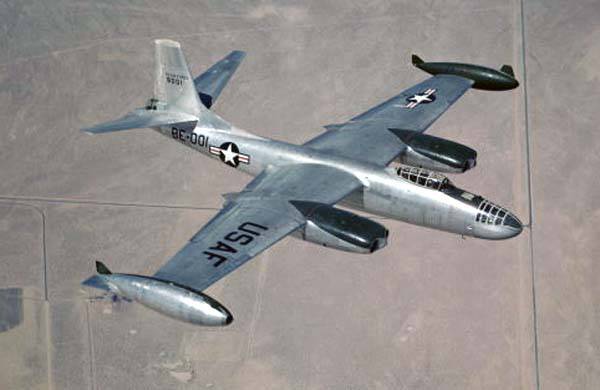
1 May 1952 of the year from a height of the order of 6000 m and speed 450 km / h B-45 carried out the dropping of the Mk bomb. 7, with a capacity of about 19 CT at a landfill in the Nevada desert. After returning, measuring the radioactive background and testing the systems, the full suitability of the Tornado for atomic bombing was established.
Carriers transferred to the British Isles. Somewhat later, Tornadoes were deployed at bases in France, Germany and Turkey. The range of these bombers allowed the US Air Force to select targets in the territory of any European state that is part of the Warsaw Pact. In 1955, the B-45 in Europe was replaced by a new Douglas B-66 Distroer bomber.
In the Korean War, only intelligence "Tornado" took part - RВ-45С-1. Most likely, the Soviet MiG-15, who fought in the skies of Korea, became the main reason for the limited use of the first reactive heavy machine by the US Air Force. Fear of inevitable large losses and forced the Yankees to limit the use of jet "Tornado." Not the small role in this was played by the extremely high cost of the aircraft (even the strategic B-29 cost much less).
All RB-45-1, trapped in Korea, were summarized in 91-e "Strategic Intelligence Wing" - the best intelligence unit in the US Air Force at that time. In addition to the “Tornado”, it flew WW-26, RB-50, PS-36 and RB-29.
The first RB-45-1 began to arrive in Japan after the start of the fighting. The Misawa and Yokota airbases became the home for the Tornado.
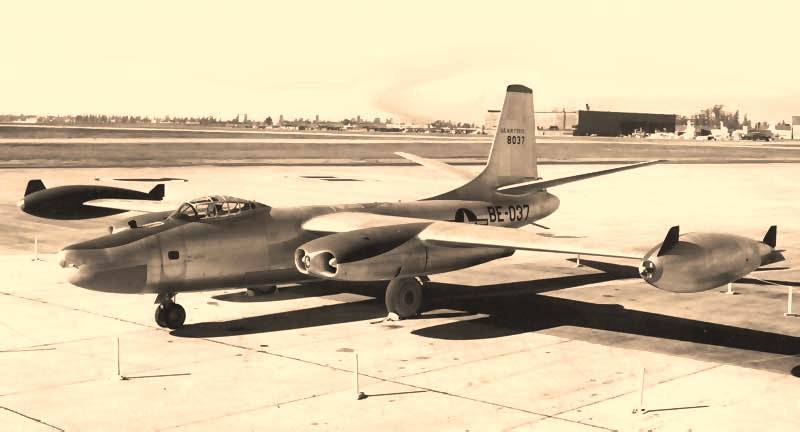
At the end of the fall, the reconnaissance aircraft began to carry out reconnaissance flights. The main objectives for reconnaissance jets were identified North Korean airfields. RВ-45, were virtually invulnerable to the piston La-9 and Yak-9, and could perform their tasks with impunity.
However, with the advent of the MiG-15, the situation has changed dramatically. Thus, as early as December 1950, a pair of MiG-15 from 29-GIAP, consisting of captains A. Andrianov and A. Kurnosov, attacked and shot down RВ-45С-1 near Andund. The crew of the scout catapulted and was captured by North Korean soldiers. However, this loss did not affect the flights of the Tornado, as only this jet reconnaissance had the opportunity to "get" North Korean airfields from Japanese air bases, while there was still a chance to return.
However, further events showed that the RB-45 simply attracted the North Korean fighters. For example, in April 1951, one of the Tornadoes flew out to scout airfields north of the Yalu River. At this time, there was a change in the composition of the 64 of the United States, and the Americans watched all movements of aviation units. After photographing a number of airfields, the RВ-45 began to leave the danger zone, and at that time MiG-15 from the 196-iap came under fire. The scout failed to shoot down the first attack, but the MiG pilot didn’t manage to retry, - at top speed, with a decrease, the Tornado went south to the peninsula and returned to its base. The post-flight inspection showed that as a result of the MiG attack, the cameras located in the middle part of the fuselage were completely broken and the rescue boat was tattered into rags. In the same month, MiG pilot N. Shelamanov managed to knock out another RВ-45, which was forced to make an emergency landing near Pyongyang. The aircraft was not subject to recovery.
Summing up the Korean War, the Americans completely deny the losses of the Tornado. But you should not trust such statements. An indirect confirmation of the fact that the Yankees are cunning, can serve as an emergency transfer of two additional RB-45С-1 from Alaska to Japan, which became the first transatlantic flight of jet aircraft. At the same time, the RВ-45 was refueled twice in the air. The cars covered the distance in 3640 miles in 9 hours 50 minutes.
November 9 1951-th, there was another meeting of the RB-45 with "Migami". The Tornado was flying at an altitude of 12000 m, when eight MiG-15 immediately went on the attack. The inexperience of the MiG pilots did not allow them to achieve a seemingly easy victory. Although MiGs released all of their ammunition for reconnaissance, the RB-45 returned to the base without damage.
During the war, the American command determined the range of tasks that were assigned to each type of equipment. Say, the RВ-29 and RВ-50, which initially conducted strategic reconnaissance, both in the daytime and at night, with the use of high-speed MiG-15 in the sky of the peninsula, switched exclusively to night flights. The RB-45 was assigned to control aerodromes, on which the enemy fighters were based. On reconnaissance flights "Tornado" flew, as a rule, during the day, much less often - at night. In the case of the appearance of MiG-15 in the sky, the Americans turned around and scooted at maximum speed towards the sea, since the Migam was strictly forbidden to fly there.
The RВ-45С-1 continued to conduct reconnaissance until the very end of the war, although since the summer of 1951, some of their reconnaissance functions were transferred to the tactical reconnaissance RF-80 and RF-86.
After the Korean War, the RВ-45С continued to be used for reconnaissance flights near the borders of the DPRK, China and the USSR, sometimes flying into the airspace of these states, which led to the occurrence of military incidents. In particular, on January 27, the 1954-th Chinese MiG-15 attacked the RВ-45С-1, which violated the border. The plane received significant damage and did not reach the airfield. A year later, 5 February 1955-th over the Yellow Sea, again, the Chinese pilots intercepted another Tornado. However, this time the American F-86, who had come to the aid of their scout, were able to repel the attack of the MiG, killing at the same time two MiGs.
Tornado B-45 / RB-45 of various modifications were in service with the US Air Force from 1948-th to 1958-th year, after which they were gradually cut into metal. The last car to fly into the air was the B-45-5, which flew in 1971 year to the site of the National Museum of Aviation and Astronautics of the United States. In total, 142 B-45 of all modifications was released.
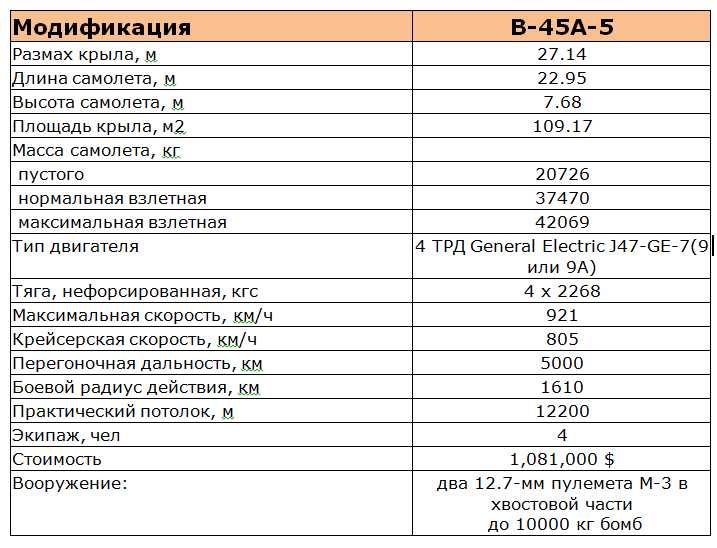
Sources:
Okolelov N., Chechin A. B-45 "Tornado" // All jet planes of the Korean War. M .: Yauza, 2014. C.233-244.
Kolov S. "Tornado" with the atomic bomb // Wings of the Motherland. 2001. No.9. C.18-21.
Okolelov N., Chechin A. American "Smerch" // Wings of the Motherland. 1997. No.11. C.14-22.
Okolelov N., Chechin A. First US jet bomber. / / Modeller Constructor. 2000. No.12. C.27-30.
Kuznetsov K., Dyakonov G. The main caliber of aviation // Aviation and Cosmonautics. 2013. No.4. C.39.
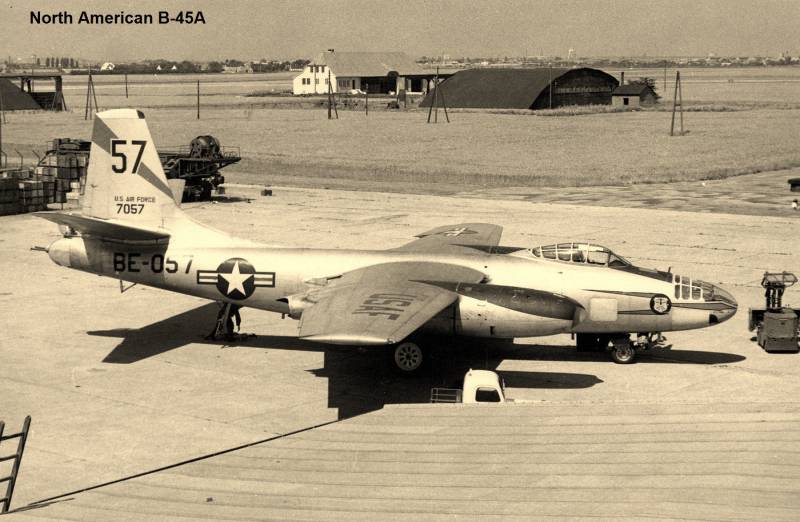
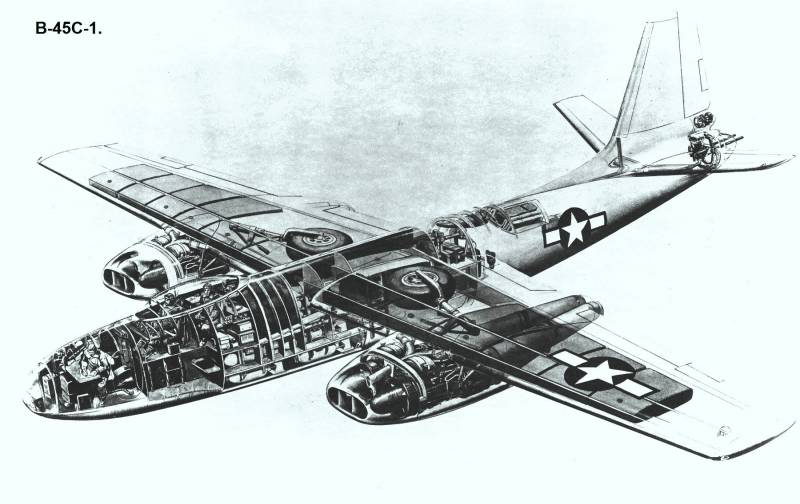
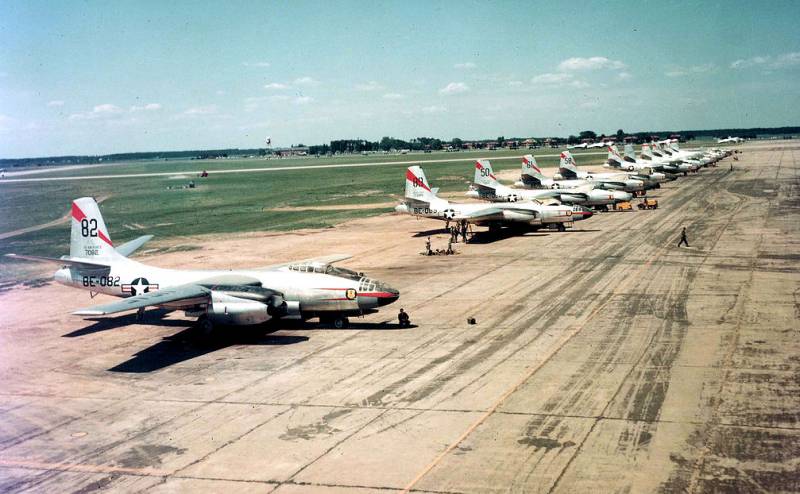
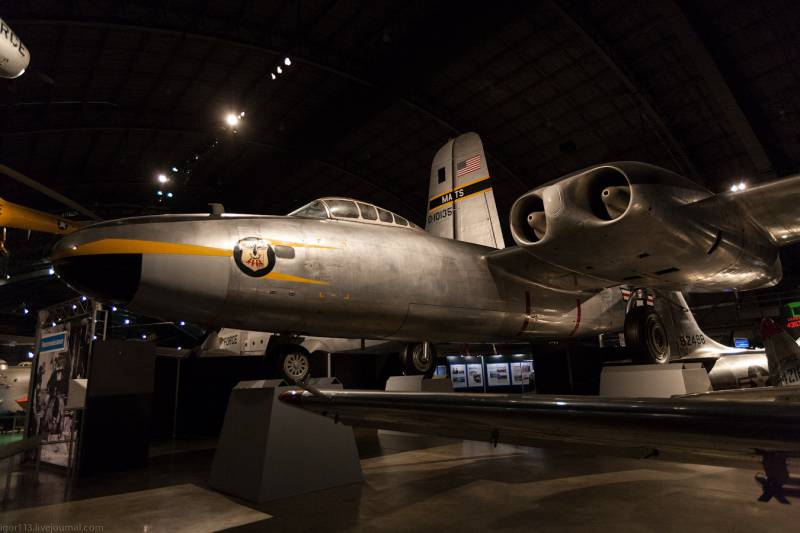
Information